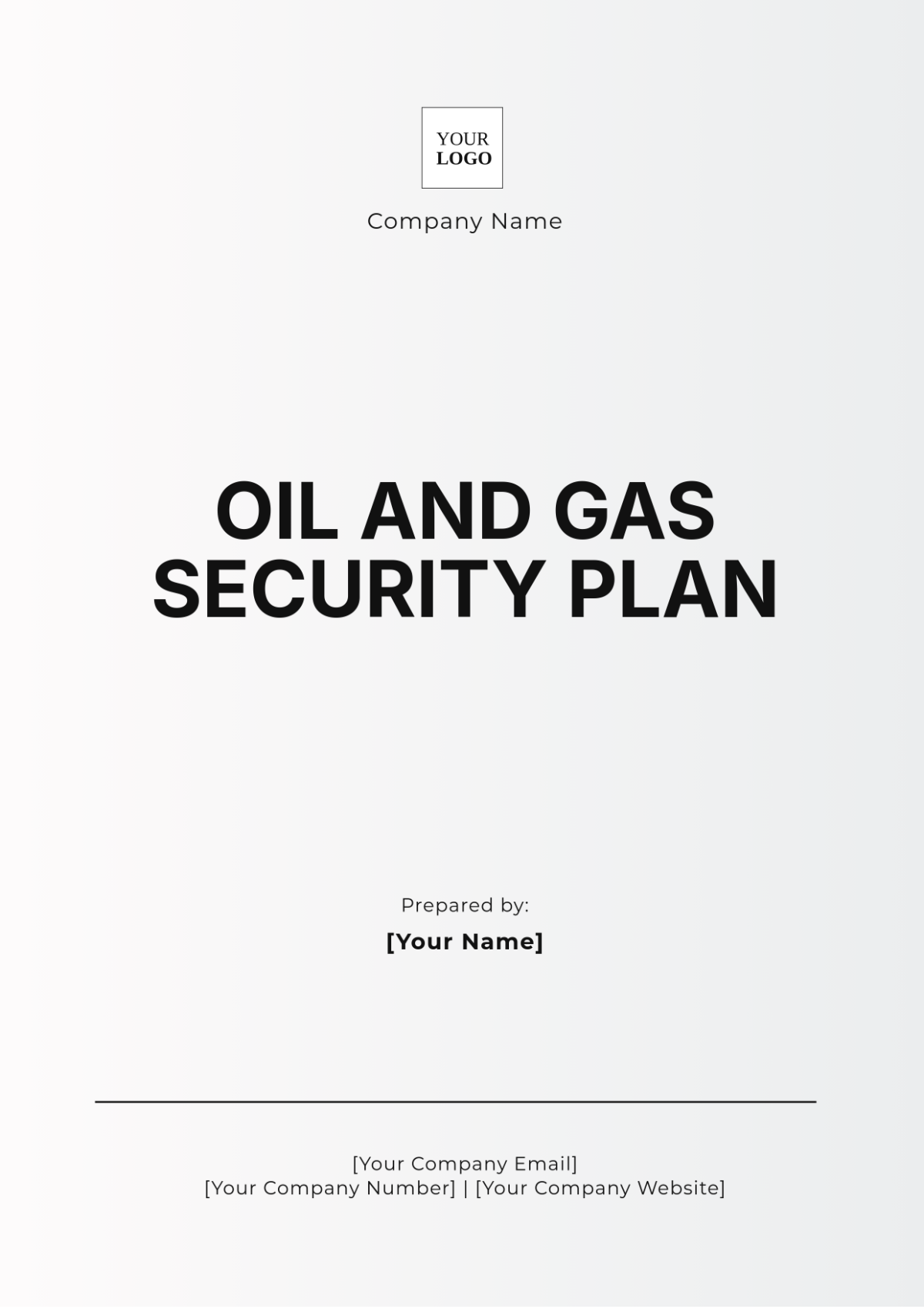Free Oil and Gas Security Plan

I. Introduction
The oil and gas industry is a cornerstone of the global economy, fueling industries, powering homes, and driving technological advancements. Given its vital role, ensuring the security of operations, infrastructure, and systems is paramount to preventing potential economic downturns and environmental catastrophes. This security plan outlines comprehensive measures to protect the industry's assets against a spectrum of threats, ranging from physical attacks to cyber intrusions, ensuring the safety of personnel, the environment, and the financial integrity of operations.
II. Risk Assessment
1. Identifying Threats
A thorough identification of potential threats is essential for effective security planning. The following categories encompass the main threats faced by the oil and gas sector:
Physical Threats:
Terrorism: Targeted attacks on facilities can disrupt operations and threaten lives.
Theft: theft of equipment, materials, or intellectual property poses a significant risk.
Sabotage: Intentional damage to infrastructure can lead to substantial financial losses and environmental disasters.
Cyber Threats:
Hacking: Unauthorized access to sensitive information or control systems can result in operational disruptions.
Phishing Scams: Deceptive emails can trick employees into revealing confidential information.
Malware Attacks: Malicious software can corrupt systems, leading to data loss and operational downtime.
Natural Disasters:
Earthquakes: Seismic activities can cause structural damage to facilities.
Hurricanes: severe weather events can disrupt supply chains and damage infrastructure.
Floods: Flooding can pose risks to onshore and offshore operations, necessitating robust contingency planning.
Insider Threats:
Unintentional Breaches: Lack of training or awareness can lead to accidental data leaks or security violations.
Intentional Sabotage: Disgruntled employees may seek to harm the organization through sabotage or information theft.
2. Vulnerability Analysis
A comprehensive vulnerability assessment is essential for identifying weak points in both physical infrastructure and digital systems. This includes evaluating:
Physical Security: Assessing the resilience of fences, gates, lighting, and surveillance systems.
Cybersecurity: Analyzing the robustness of software applications, network configurations, and data storage practices.
3. Impact Evaluation
Conduct a detailed analysis to assess the potential impact of identified threats on operations. This includes quantifying possible financial losses, regulatory fines, reputational damage, and environmental consequences, which will guide the prioritization of security measures.
III. Security Measures
1. Physical Security
To mitigate physical threats, the following measures should be implemented:
Installation of Surveillance Systems: Deploy advanced surveillance cameras and monitoring systems to ensure real-time oversight of critical areas.
Access Control Systems: Implement biometric access controls and ID card systems to restrict entry to authorized personnel only.
Regular security drills and exercises: Conduct routine drills to prepare employees for emergency situations, ensuring they are familiar with evacuation routes and response protocols.
2. Cybersecurity
Robust cybersecurity measures are essential to defend against digital threats.
Implementation of Firewalls and Intrusion Detection Systems: utilize advanced firewalls and IDS to monitor network traffic and detect unauthorized access attempts.
Regular Software Updates and Patch Management: Maintain a strict schedule for software updates to protect against vulnerabilities.
Data Encryption and Network Security Protocols: Encrypt sensitive data and enforce strict network security protocols to safeguard against data breaches.
Employee Training on Cybersecurity Awareness: Provide ongoing training for employees to recognize potential cyber threats and respond appropriately.
3. Policies and Procedures
Develop comprehensive policies to ensure a proactive approach to security:
Emergency Response Procedures: Establish clear protocols for responding to various emergencies, including natural disasters, cyber incidents, and security breaches.
Incident Reporting and Management: Create a structured system for reporting security incidents to ensure timely response and documentation.
Data Protection and Privacy Policies: Implement stringent policies to protect sensitive data and comply with relevant data protection regulations.
IV. Training and Awareness
1. Employee Training
Conduct regular training sessions tailored to various roles within the organization, ensuring employees understand their responsibilities concerning security protocols and best practices.
2. Awareness Campaigns
Implement ongoing awareness campaigns to educate all stakeholders—including contractors and suppliers—about the importance of security and their critical role in maintaining a secure environment.
V. Monitoring and Evaluation
1. Regular Audits
Conduct periodic audits of security measures to assess their effectiveness and compliance with established policies. These audits should include both physical and cyber components, identifying areas for improvement.
2. Continuous Improvement
Utilize audit findings to enhance security strategies and practices continually. Implement a feedback loop that allows for the adaptation of security measures in response to emerging threats and changes in the operational landscape.
- 100% Customizable, free editor
- Access 1 Million+ Templates, photo’s & graphics
- Download or share as a template
- Click and replace photos, graphics, text, backgrounds
- Resize, crop, AI write & more
- Access advanced editor
Enhance your organization's safety protocols with the Oil and Gas Security Plan Template. This customizable and downloadable resource provides a comprehensive framework to address potential risks in the oil and gas industry. Printable for convenience, it allows for easy distribution among your team. Additionally, this template is editable in our AI Editor Tool, ensuring you can tailor it to meet your specific needs.
You may also like
- Finance Plan
- Construction Plan
- Sales Plan
- Development Plan
- Career Plan
- Budget Plan
- HR Plan
- Education Plan
- Transition Plan
- Work Plan
- Training Plan
- Communication Plan
- Operation Plan
- Health And Safety Plan
- Strategy Plan
- Professional Development Plan
- Advertising Plan
- Risk Management Plan
- Restaurant Plan
- School Plan
- Nursing Home Patient Care Plan
- Nursing Care Plan
- Plan Event
- Startup Plan
- Social Media Plan
- Staffing Plan
- Annual Plan
- Content Plan
- Payment Plan
- Implementation Plan
- Hotel Plan
- Workout Plan
- Accounting Plan
- Campaign Plan
- Essay Plan
- 30 60 90 Day Plan
- Research Plan
- Recruitment Plan
- 90 Day Plan
- Quarterly Plan
- Emergency Plan
- 5 Year Plan
- Gym Plan
- Personal Plan
- IT and Software Plan
- Treatment Plan
- Real Estate Plan
- Law Firm Plan
- Healthcare Plan
- Improvement Plan
- Media Plan
- 5 Year Business Plan
- Learning Plan
- Marketing Campaign Plan
- Travel Agency Plan
- Cleaning Services Plan
- Interior Design Plan
- Performance Plan
- PR Plan
- Birth Plan
- Life Plan
- SEO Plan
- Disaster Recovery Plan
- Continuity Plan
- Launch Plan
- Legal Plan
- Behavior Plan
- Performance Improvement Plan
- Salon Plan
- Security Plan
- Security Management Plan
- Employee Development Plan
- Quality Plan
- Service Improvement Plan
- Growth Plan
- Incident Response Plan
- Basketball Plan
- Emergency Action Plan
- Product Launch Plan
- Spa Plan
- Employee Training Plan
- Data Analysis Plan
- Employee Action Plan
- Territory Plan
- Audit Plan
- Classroom Plan
- Activity Plan
- Parenting Plan
- Care Plan
- Project Execution Plan
- Exercise Plan
- Internship Plan
- Software Development Plan
- Continuous Improvement Plan
- Leave Plan
- 90 Day Sales Plan
- Advertising Agency Plan
- Employee Transition Plan
- Smart Action Plan
- Workplace Safety Plan
- Behavior Change Plan
- Contingency Plan
- Continuity of Operations Plan
- Health Plan
- Quality Control Plan
- Self Plan
- Sports Development Plan
- Change Management Plan
- Ecommerce Plan
- Personal Financial Plan
- Process Improvement Plan
- 30-60-90 Day Sales Plan
- Crisis Management Plan
- Engagement Plan
- Execution Plan
- Pandemic Plan
- Quality Assurance Plan
- Service Continuity Plan
- Agile Project Plan
- Fundraising Plan
- Job Transition Plan
- Asset Maintenance Plan
- Maintenance Plan
- Software Test Plan
- Staff Training and Development Plan
- 3 Year Plan
- Brand Activation Plan
- Release Plan
- Resource Plan
- Risk Mitigation Plan
- Teacher Plan
- 30 60 90 Day Plan for New Manager
- Food Safety Plan
- Food Truck Plan
- Hiring Plan
- Quality Management Plan
- Wellness Plan
- Behavior Intervention Plan
- Bonus Plan
- Investment Plan
- Maternity Leave Plan
- Pandemic Response Plan
- Succession Planning
- Coaching Plan
- Configuration Management Plan
- Remote Work Plan
- Self Care Plan
- Teaching Plan
- 100-Day Plan
- HACCP Plan
- Student Plan
- Sustainability Plan
- 30 60 90 Day Plan for Interview
- Access Plan
- Site Specific Safety Plan





























